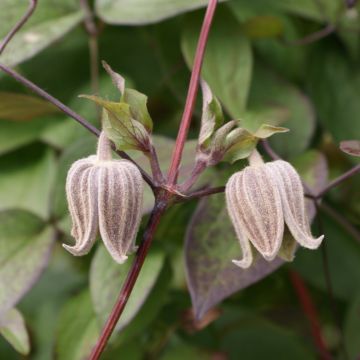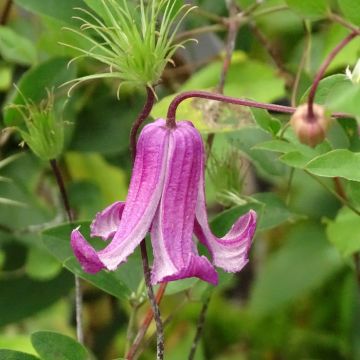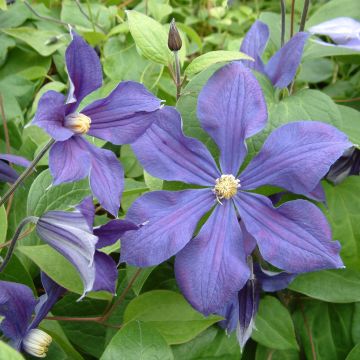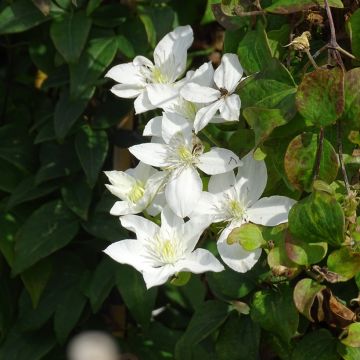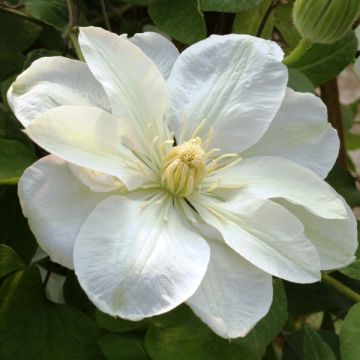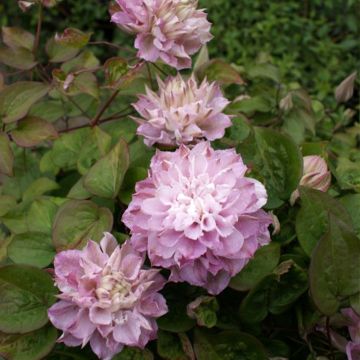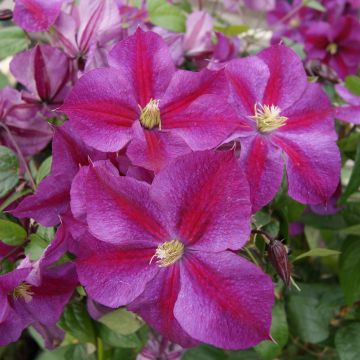

Clematis atragene alpina Francis Rivis
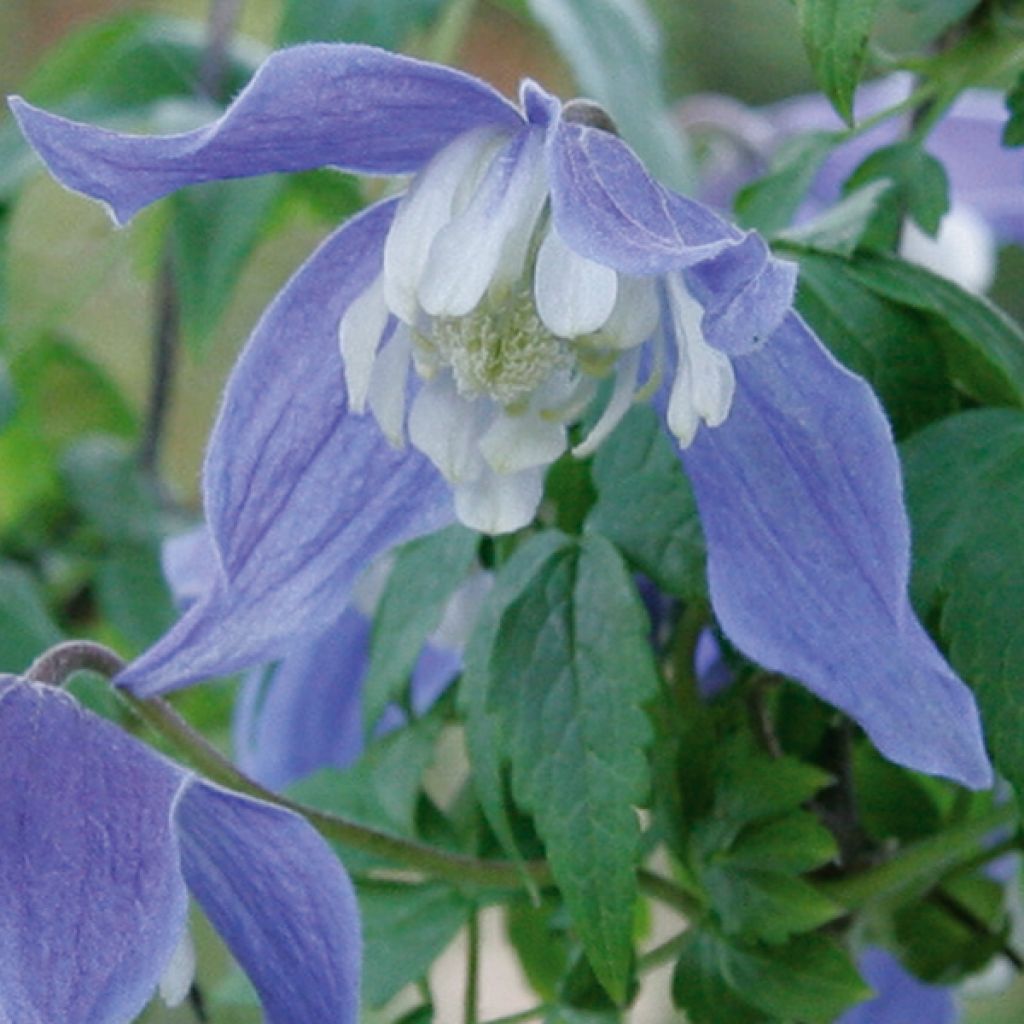

Clematis atragene alpina Francis Rivis
Clematis atragene alpina Francis Rivis
Clematis atragene alpina Francis Rivis
Alpine Clematis
This item cannot be shipped to the selected country
Delivery charge from €5.90
More information
Schedule delivery date,
and select date in basket
This plant carries a 6 months recovery warranty
More information
We guarantee the quality of our plants for a full growing cycle, and will replace at our expense any plant that fails to recover under normal climatic and planting conditions.
From €5.90 for pickup delivery and €6.90 for home delivery
Express home delivery from €8.90.

Does this plant fit my garden?
Set up your Plantfit profile →
Description
The Clematis alpina Francis Rivis is a proven variety, directly derived from the alpine clematis, from which it has inherited its earliness and hardiness. It is a sturdy climbing plant of medium size, flowering from March-April, and blooming again, although less spectacularly, in September. Its bell-shaped flowers hang down and offer a bright blue-violet colour, highlighted by a small white cup in the center. This modest-sized climber thrives on old walls, trellises, fences, but also in trees. Its numerous tendrils allow it to climb everywhere! Perfect when paired with a white rose!
The Clematis (Clematis) is a genus in the buttercup family. It includes about 30 species of herbaceous perennials with woody stems and climbing plants, semi-woody, evergreen or deciduous. They are found in both hemispheres, especially in Europe, the Himalayas, China, Australia, North and Central America. The Clematis 'Francis Rivis' is a famous English cultivar, dating from 1965, awarded in 1993 with a Royal Horticultural Society "Award of Garden Merit". It is derived from the Clematis alpina (section Clematis Tetragene), showing larger flowers. It belongs to Group 1 (early-flowering clematis) of the Clematis, which has 3 groups. It is a semi-woody, climbing perennial plant that reaches a height of 2.50m (8ft) to 3m (10ft), with a spread of 1m (3ft). The groups are defined based on cultural requirements.
This Clematis Francis Rivis bears beautiful narrow bell-shaped flowers, 5-6cm (2in) in diameter, in the axils of the leaves, on the previous year's shoots. They bloom from March onwards if the weather is mild. The bisexual flowers are solitary. They have no petals but have 4 slightly twisted sepals. In the center of the corolla are white staminodes (sterile stamens arranged in a small cup), surrounding true cream-white stamens. The flowering is followed by decorative, silvery-gray feathery fruits. The glabrous leaves, sometimes opposite, sometimes alternate, are simple, tripalmate, with irregularly serrated edges. This clematis clings to the support or host plant with the help of petioles transformed into tendrils.
We have planted it on a pergola with a white rose. Its flowers are very attractive before the roses appear, and they harmoniously blend in late summer, when both plants bloom again together.
The name "clematis" comes from the Greek "klema" = vine shoot, because its old stems have a woody and twisted appearance with exfoliations of its cork. Half a dozen wild clematis species grow in France (not counting those cultivated in gardens). Among them are the Alpine Clematis (or Alpine Clematis), and the Traveller's Joy (Clematis vitalba), whose fresh leaves are highly vesicant; indeed, by simple contact, when crushed, "burns" appear on the skin. In the past, professional beggars rubbed the wood clematis ("herbe aux gueux") on their wounds to create superficial and extensive ulcers, with the aim of arousing sympathy from donors.
Report an error about the product description
Clematis atragene alpina Francis Rivis in pictures


Plant habit
Flowering
Foliage
Botanical data
Clematis
atragene alpina
Francis Rivis
Ranunculaceae
Alpine Clematis
Cultivar or hybrid
Other Bell-flower Clematis
Planting and care
Plant the clematis preferably in the sun or partial shade, in a fertile, humus-rich, well-drained soil, shading the roots and the base of the stem (with a flat tile for example). Herbaceous species prefer full sun. Clematis withers in overly moist soil. Clematis like to have their feet cool. Install your plant by covering the root ball with 3 cm (1in) of soil, in a soil worked to a depth of 20 cm (8in), lightened with good compost. During the first few weeks, water abundantly and regularly. Mulch all clematis in February with garden compost or well-decomposed manure, avoiding direct contact with the stems. Cover the base of climbing clematis with a small mound of soil, in order to reduce the risk of withering, while promoting the emergence of vigorous shoots from the stump. After planting, prune the stems of deciduous climbing clematis to about 30 cm (12in) above a nice pair of buds. We advise you not to overwater, stagnant water can cause the development of a fungus at the neck. Train the stems, without squeezing them, until the plant grips itself. Clematis also like to grow freely on neighboring plants.
Prune "Group 1" clematis after flowering, to 75 cm (0 to 30in). Remove dead or damaged stems, shorten others if necessary. This promotes the formation of new shoots for the following year. Voles and grey worms can attack clematis and devour the stems. Aphids and greenhouse whiteflies are also potential parasites of clematis.
Planting period
Intended location
Care
-
, onOrder confirmed
Reply from on Promesse de fleurs
Clematis
Haven't found what you were looking for?
Hardiness is the lowest winter temperature a plant can endure without suffering serious damage or even dying. However, hardiness is affected by location (a sheltered area, such as a patio), protection (winter cover) and soil type (hardiness is improved by well-drained soil).

Photo Sharing Terms & Conditions
In order to encourage gardeners to interact and share their experiences, Promesse de fleurs offers various media enabling content to be uploaded onto its Site - in particular via the ‘Photo sharing’ module.
The User agrees to refrain from:
- Posting any content that is illegal, prejudicial, insulting, racist, inciteful to hatred, revisionist, contrary to public decency, that infringes on privacy or on the privacy rights of third parties, in particular the publicity rights of persons and goods, intellectual property rights, or the right to privacy.
- Submitting content on behalf of a third party;
- Impersonate the identity of a third party and/or publish any personal information about a third party;
In general, the User undertakes to refrain from any unethical behaviour.
All Content (in particular text, comments, files, images, photos, videos, creative works, etc.), which may be subject to property or intellectual property rights, image or other private rights, shall remain the property of the User, subject to the limited rights granted by the terms of the licence granted by Promesse de fleurs as stated below. Users are at liberty to publish or not to publish such Content on the Site, notably via the ‘Photo Sharing’ facility, and accept that this Content shall be made public and freely accessible, notably on the Internet.
Users further acknowledge, undertake to have ,and guarantee that they hold all necessary rights and permissions to publish such material on the Site, in particular with regard to the legislation in force pertaining to any privacy, property, intellectual property, image, or contractual rights, or rights of any other nature. By publishing such Content on the Site, Users acknowledge accepting full liability as publishers of the Content within the meaning of the law, and grant Promesse de fleurs, free of charge, an inclusive, worldwide licence for the said Content for the entire duration of its publication, including all reproduction, representation, up/downloading, displaying, performing, transmission, and storage rights.
Users also grant permission for their name to be linked to the Content and accept that this link may not always be made available.
By engaging in posting material, Users consent to their Content becoming automatically accessible on the Internet, in particular on other sites and/or blogs and/or web pages of the Promesse de fleurs site, including in particular social pages and the Promesse de fleurs catalogue.
Users may secure the removal of entrusted content free of charge by issuing a simple request via our contact form.
The flowering period indicated on our website applies to countries and regions located in USDA zone 8 (France, the United Kingdom, Ireland, the Netherlands, etc.)
It will vary according to where you live:
- In zones 9 to 10 (Italy, Spain, Greece, etc.), flowering will occur about 2 to 4 weeks earlier.
- In zones 6 to 7 (Germany, Poland, Slovenia, and lower mountainous regions), flowering will be delayed by 2 to 3 weeks.
- In zone 5 (Central Europe, Scandinavia), blooming will be delayed by 3 to 5 weeks.
In temperate climates, pruning of spring-flowering shrubs (forsythia, spireas, etc.) should be done just after flowering.
Pruning of summer-flowering shrubs (Indian Lilac, Perovskia, etc.) can be done in winter or spring.
In cold regions as well as with frost-sensitive plants, avoid pruning too early when severe frosts may still occur.
The planting period indicated on our website applies to countries and regions located in USDA zone 8 (France, United Kingdom, Ireland, Netherlands).
It will vary according to where you live:
- In Mediterranean zones (Marseille, Madrid, Milan, etc.), autumn and winter are the best planting periods.
- In continental zones (Strasbourg, Munich, Vienna, etc.), delay planting by 2 to 3 weeks in spring and bring it forward by 2 to 4 weeks in autumn.
- In mountainous regions (the Alps, Pyrenees, Carpathians, etc.), it is best to plant in late spring (May-June) or late summer (August-September).
The harvesting period indicated on our website applies to countries and regions in USDA zone 8 (France, England, Ireland, the Netherlands).
In colder areas (Scandinavia, Poland, Austria...) fruit and vegetable harvests are likely to be delayed by 3-4 weeks.
In warmer areas (Italy, Spain, Greece, etc.), harvesting will probably take place earlier, depending on weather conditions.
The sowing periods indicated on our website apply to countries and regions within USDA Zone 8 (France, UK, Ireland, Netherlands).
In colder areas (Scandinavia, Poland, Austria...), delay any outdoor sowing by 3-4 weeks, or sow under glass.
In warmer climes (Italy, Spain, Greece, etc.), bring outdoor sowing forward by a few weeks.

































